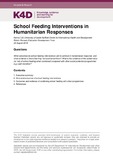| dc.description.abstract | School feeding interventions aim to support food and nutrition security, improved learning and educational outcomes, and social needs and social safety nets in humanitarian crises. Evidence about their impact is limited and mixed. In terms of the value added by school feeding initiatives when combined with other social protection programmes, evidence suggests that programmes operating cash transfers provide greater opportunities for improving school participation, but generally tend not to improve learning outcomes although some individual programmes have demonstrated positive results.
The main findings in the literature on school feeding programmes specifically in humanitarian contexts that we were able to identify in the time available for this report are:
- Children’s access to food and protection from deprivation are elementary and primary functions of emergency school feeding (Hatløy & Sommerfelt, 2017:5).
- Nutritional impacts of school feeding in humanitarian contexts are less often documented, in part because the age group reached directly is less at risk of undernutrition than younger (pre-school) children (Gentilini, 2016).
- In crisis settings, increased school attendance and reduction in school-drop out objectives are regularly met by school feeding and Food for Education (FFE) programmes (Gentilini, 2016).
- Protection (against child labour, recruitment into armed forces, and early marriage) cannot be a stand-alone objective of a humanitarian intervention, but must be a co-objective, alongside aims to improve children’s food access, nutrition and educational access (Hatløy & Sommerfelt, 2017:35). In a case in South Sudan, school feeding ‘pulled’ children from other schools to the schools supported by school meals, which resulted in some children walking longer distances to school and which could result in protection risks (UNICEF SSEC, 2018:13).
- When responding to natural disasters or economic or political shocks, relationships with governments from the national to the local level are key to successful school feeding programmes (Berger-Fenning & Keylock, 2017), especially as there is a tendency to favour local purchase of food for ‘home grown’ programmes which support local (smallholder) agriculture as well as reduce costs.
- Food for Education (FFE) is considered a safety net during times of crisis, but is not a substitute for a well-organised education system and teacher performance (Alderman and Bundy, 2011:213). FFE programmes can only be effective in education terms if combined with quality education programmes (Alderman and Bundy, 2011:213).
- The school feeding system is potentially an important base for shock-response and humanitarian assistance. Despite concerns about capacity, FFE has proven flexible in response to crises. However, the flexibility in the system is currently provided by WFP and its partners. Governments can only adjust their own school meals programme to respond to an emergency if they handle two capacity requirements that this would impose: additional material resources and timely financing (O’Brien et al., 2018:31).
- School feeding programmes (SFPs) often provide more food, and food of higher nutritional quality, than take-home ration (THR) programmes (Alderman et al., 2012:193). In general, both SFP and THR programmes perform similarly well; for example, significant positive impacts on attendance in both in-school meals and THR programmes have been reported in Internally Displaced Person (IDP) camps in Northern Uganda. However, school meals may have the unintended effect of increasing the time taken to complete primary school because the child is motivated to attend through the provision of meals and may place less emphasis on the learning environment (Alderman et al., 2012:190-192). | en |

